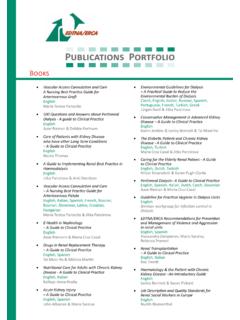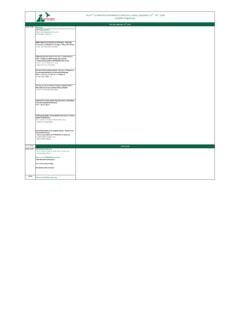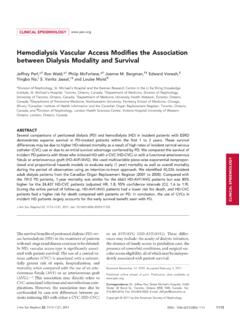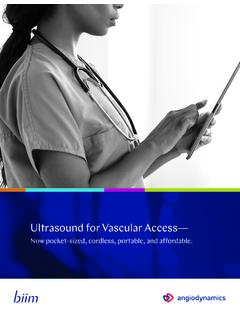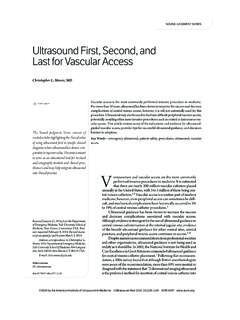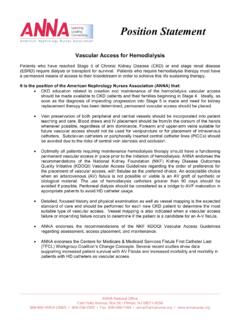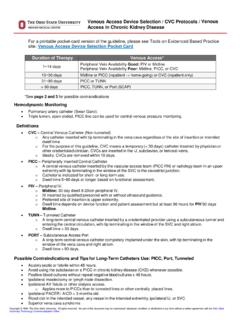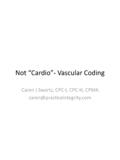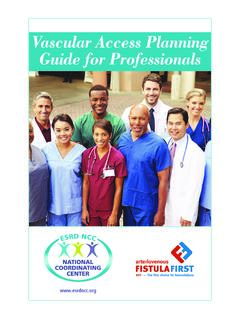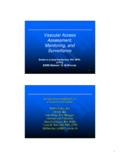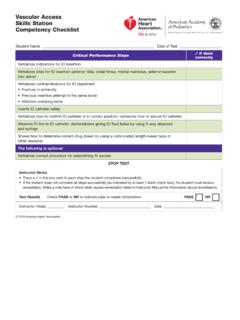Transcription of Vascular Access - EDTNA/ERCA
1 Vascular AccessCannulation and CareA Nursing Best Practice Guide for Arteriovenous FistulaEditorsMaria Teresa Parisotto Jitka PancirovaVascular Access Cannulation and CareA Nursing Best Practice Guide for Arteriovenous FistulaThis book is an initiative of Maria Teresa Parisotto (Director Nursing Care Management, NephroCare Coordination, Fresenius Medical Care Deutschland GmbH), Germany and Jitka Pancirova, ( EDTNA/ERCA Executive Director), Czech RepublicAuthors of this best practice guide are:Alberto Garcia Iglesias RN, Spain Cristina Miriunis RN, , Germany Dr. Francesco Pelliccia RN, MSc, Italy Iain Morris RN, United Kingdom Iris Romach RN, MA, Israel Joao Fazendeiro Matos RN, BSc, MBA (c), Portugal Mihai Preda RN, , Romania Nicola Ward RN, United Kingdom Raffaella Beltrandi RN, Italy Ricardo Peralta RN, BSc, Portugal Theodora Kafkia RN, MSc, PhD (c), Clinical Lecturer, GreeceContributors to this best practice guide are:Jean Pierre Van Waeleghem RN, BSN, BelgiumVictor Moscard RN, GermanyDr.
2 Frank Laukhuf MD, Nephrologist, GermanyVolker Schoder , Dipl. Statistician, GermanyProf. Dr. Daniele Marcelli MD, MBA, Nephrologist, Epidemiologist, GermanyDr. Adelheid Gauly PhD, MBA, GermanyDr. Stefano Stuard MD, PhD, Nephrologist, GermanyReviewers of this best practice guide are:Dr. Richard Fluck FRCP, MA (Cantab), MBBS, Nephrologist Immediate past President, British Renal Society, United KingdomDr. Maurizio Gallieni MD, FASN, Nephrologist, Researcher at University of Milan President, the Vascular Access Society, ItalyDr. Otto Arkossy MD, Nephrologist Board Member of the Hungarian Society of Nephrology, HungaryEmine Unal RN, TurkeyNatalie Beddows RN, United Kingdom Marjelka Trkulja RN, EDTNA/ERCA Brand Ambassador, CroatiaAll rights are reserved by the author and publisher, including the rights of reprinting, reproduction in any form and translation.
3 No part of this book may be reproduced, stored in a retrieval system or transmitted, in any form or by means, electronic, mechanical, photocopying, recording, or otherwise, without the prior written permission of the included in this publication are property of Fresenius Medical Care Deutschland GmbH and cannot be used without prior permission of the edition: September 2014 European Dialysis and Transplant Nurses Association/ European Renal Care Association ( EDTNA/ERCA )Pilatusstrasse 35, CH 6003 Lucerne, : : M-17528-2014 Layout, Binding and Printing: Imprenta Tom s Hermanos R o Manzanares, 42-44 E28970 Humanes de MadridMadrid - Access Cannulation and Care A Nursing Best Practice Guide for Arteriovenous FistulaAcknowledgementsThis book is an initiative of Fresenius Medical Care and EDTNA/ERCA .
4 We warmly thank the authors, the contributors and the reviewers for their collaboration and enthusiasm on this project. The content created is an excellent example of multidisciplinary, international teamwork, developing best practice guide for the most important aspect of the haemodialysis patient s Teresa Parisotto, Director Nursing Care Management, NephroCare Coordination, Fresenius Medical Care Deutschland GmbH, Bad Homburg, GermanyJitka Pancirova, EDTNA/ERCA Executive Director, Prague, Czech RepublicSponsorFresenius Medical Care Deutschland GmbH has kindly supported the development of Vascular Access Cannulation and Care.
5 A Nursing Best Practice Guide for Arteriovenous Fistula . This handbook is the result of the of Contents1112 Vascular Access Cannulation and Care A Nursing Best Practice Guide for Arteriovenous Fistula1. Preface .. 17 2. Executive summary .. 23 3. Introduction .. Aims for the use of this best practice guide .. Groups likely to benefit from this best practice guide .. Scope of this best practice guide .. 304. Background .. 335. Vascular Access for Haemodialysis .. VA types .. 386. Arteriovenous Fistula .. Timing for Arteriovenous Fistula creation .. Selection of vessels .. Artery .. Vein .. Location of Arteriovenous Fistula creation.
6 Surgical technique of anastomosis creation .. Maturation .. Physiology of maturation .. Timing of maturation .. Failure of Arteriovenous Fistula maturation .. Instrumental monitoring of Arteriovenous Fistula maturation .. 5413 Table of Contents7. Hygiene and infection control .. Hand hygiene .. Personal Protective Equipment (PPE) and work uniform .. Gloving .. Face protection .. Aprons and gowns .. Uniforms .. 618. Arteriovenous Fistula cannulation .. Competencies and responsibilities .. Preparation and assessment .. Preparation .. Assessment.
7 Arteriovenous Fistula preparation .. First cannulation .. Procedure .. Cannulation techniques .. Rope ladder .. The buttonhole technique .. Area technique .. Trypanophobia (fear of needles) .. Needle removal and Haemostasis .. Complications related to Arteriovenous Fistula Cannulation . Haematoma/infiltration .. Pseudo-Aneurysm .. Infections .. 9314 Vascular Access Cannulation and Care A Nursing Best Practice Guide for Arteriovenous Fistula9. Complications of Arteriovenous Fistula (related to the fistula) .. Stenosis .. Thrombosis .. Aneurysms .. Complications caused by the Arteriovenous Fistula.
8 Cardiac Complications .. Steal syndrome .. 10610. Arteriovenous Fistula monitoring and evaluation .. Arteriovenous Fistula monitoring .. Dynamic venous and arterial pressures evaluation .. Measurements of blood recirculation .. Dialysis efficiency .. Arteriovenous Fistula instrumental evaluation . 11311. Reporting of Arteriovenous Fistula incidents .. What, When and Why to report .. Reporting tools .. Paper charts .. E-charts .. Corrective Follow-up of corrective actions .. 12915 Table of Contents12. Patient education for the care of Arteriovenous Fistula.
9 Preservation of vessels prior to Arteriovenous Fistula creation .. Arteriovenous Fistula care .. Creation .. Arteriovenous fistula maturation .. Protect the lifeline things to consider in the patient s daily life .. Arteriovenous Fistula complications .. 13813. From empiric evaluation to clinical research evidence .. Recommendations for best cannulation practice .. 14914. Conclusions .. 15315. Appendix .. Table of abbreviations .. Bibliography .. 15916. Index .. 165 Preface1718 Vascular Access Cannulation and Care A Nursing Best Practice Guide for Arteriovenous FistulaFinally Revealed: Vascular Access A long awaited Guide to the Art of Needling Vascular Access is considered to be both the lifeline and the Achilles heel of the end-stage renal disease patient.
10 Des-pite progress and best practice recommendations, Vascular Access remains the weak point of the renal replacement ther-apy chain, generating a significant burden for the patient and the healthcare system. Vascular Access morbidity, including maturation failure, dysfunction (requiring repetitive interven-tion, revision, angioplasty), infection or more severe complica-tions (swelling of Access limb, steal syndrome, heart failure) is the third most frequent cause of hospitalisation in haemodialy-sis the technical advances in Vascular Access surgery, prosthesis development, imaging and monitoring, the autologous arteriovenous fistula (AVF)
